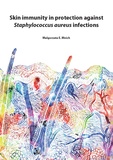Skin immunity in protection against Staphylococcus aureus infections
Summary
Defense against S. aureus infection requires the contribution of both innate and adaptive arms of the immune system. Understanding which bacterial molecules are important for the S. aureus recognition by DCs could represent an important factor in vaccine design, especially in the context of formation of T cell memory responses. In the first part of my thesis I described a new interaction between CLRs and S. aureus and how this impacted proinflammatory responses. Next, I investigated preexisting memory T cell responses towards S. aureus in the skin and blood of healthy individuals.
In Chapter 2, I describe the impact of WTA glycosylation on the recognition of S. aureus isolates from the ST395 lineage by monocyte-derived dendritic cells (moDCs). I discovered that the CLR Macrophage Galactose-Type C-Type Lectin receptor (MGL) detects these particular isolates through interaction with the GalNAc-attached glycan moiety attached to GroP-WTA. Since similar WTA structures are supposedly expressed by CoNS, I compared different S. aureus strains and coagulase-negative staphylococci (CoNS) for their interaction with recombinant and cell surface-expressed MGL. Cellular responses of primary moDCs, such as activation markers and cytokine production, were also analyzed. These results indicated that S. aureus ST395 induces MGL-dependent production of proinflammatory cytokines by moDCs. Chapter 3 describes the adaptive responses towards S. aureus in the skin of healthy subjects. S. aureus-specific Tsrm were identified in cell suspensions prepared from healthy human skin by measuring cell proliferation and cytokine production (IL-17A, IL-22, GM-CSF, IFNγ and TNFβ) in response to heat-killed S. aureus, but not S. epidermidis. This study is the first evidence of the presence of S. aureus-specific CD4+ Tsrm in the skin. Chapter 4 is dedicated to identification of S. aureus-specific CD4+ T cells in the blood of healthy subjects. Different approaches to identify these specific T cells were compared and optimized. Finally, we used an assay based on activation induced markers (AIM) and sorted cells expressing CD137 and OX40 on their surface after incubation with heat-killed S. aureus for further analysis by mRNA-sequencing. An initial analysis of the mRNA-sequencing data is presented. Chapter 5 summarizes and discusses the obtained results in the context of timely S. aureus literature on the role of skin immunity in fighting S. aureus infections. Moreover, vaccination as a preventive strategy for S. aureus infections will be discussed.
